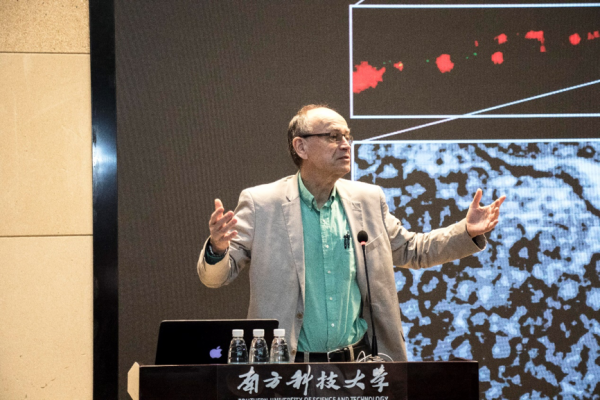March 26th saw 2013 Nobel Laureate in Physiology or Medicine , Professor Thomas C. Südhof, from Stanford University School of Medicine deliver a guest lecture entitled “Mechanisms of Synapse Formation: Neurexins and Latrophilins as Key Effectors” at Southern University of Science and Technology. It was the 213th lecture in the SUSTech Lecture Series. Professor Hou Shengtao from the Department of Biology presided over this lecture.

Professor Thomas C. Südhof originally conducted his research on cholesterol metabolism under the guidance of Professor Michael Stuart Brown and Joseph L. Goldstein. After founding his independent laboratory at University of Texas Southwestern Medical Center in 1986, Professor Südhof dedicated himself to neurobiological research where he made outstanding contributions
to understanding the molecular mechanisms of neurotransmitters in synapses . He identified numerous proteins from synapse vesicles which are involved in neurotransmission and revealed synaptotagmin, the synaptic transmembrane protein, was an efficient calcium ion sensor, while explaining the mechanisms of important interacting proteins and vesicle trafficking. Professor Südhof also shared the 2013 Nobel Laureate in Physiology or Medicine with James Rothman and Randy Schekman, for his outstanding contribution to vesicle trafficking.
Professor Südhof first described the complexity of the brain and the neural network is. He then explained the concept of neuronal circuits and proposed that synapses are the most critical element in all circuits. The formation and disappearance of synapses occur through the whole life. As an important node connecting neurons, it plays an important role in information transformation. Professor Südhof believes that regulating synapses is similar to conducting a symphony in that different molecules contribute to the entire network structure on the biochemical pathways which they belong. “What is the molecular mechanism of synaptic formation? What exactly determines the formation and processing of synaptic information?” Professor Südhof explained that exquisite interaction between synapse adhesion molecules and their ligands triggers cellular signaling pathways to determine how synapses respond and how they form. He used two cell adhesion proteins, neurexin and latrophilins, as examples to explain the mechanisms in details.

In the Q&A section, audiences actively asked questions about the role of genetic regulation in some specific stages of neurogenesis, the regulation of neurexin and the effects of related molecules on synaptic receptor function. Professor Südhof gave detailed answers one by one. When asked about the clinical treatment of neulogical diseases such as Alzheimer’s and schizophrenia, Professor Südhof admitted that while many drugs had been developed, we are not yet in a position to cure these diseases. It is however gratifying to see that the study of neurexin or synapses can help scientists and researchers explore some simpler ways to cure these diseases. Nowadays, what needs to be done is to discard our traditional thinking and try to draw a comprehensive picture of the mechanisms behind the disease. Such an approach will help develop better drugs that will treat and possibly even prevent these diseases.
Proofread ByChris Edwards, Xia Yingying
Photo ByDepartment of Biology